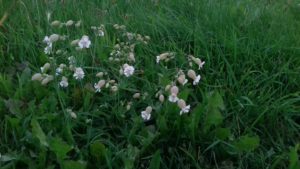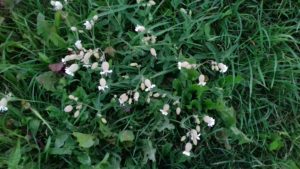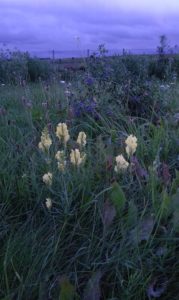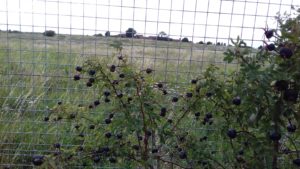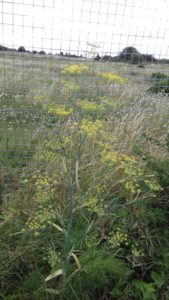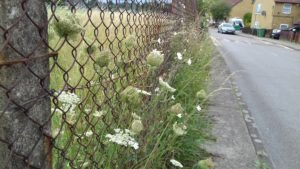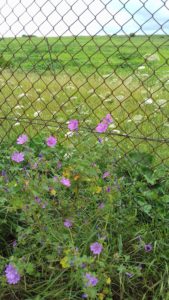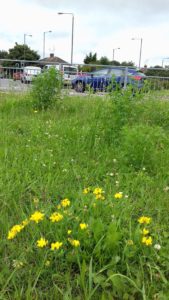Perry Street Farm, largely used for horse grazing, is now a Borough Grade 2 Site of Importance for Nature Conservation (SINC). It is private, but viewable from the north and west sides from public roadways and from the east side from Stoneham Park.
The most interesting find recently was of a single plant of Sea Campion (Silene uniflora) on the Gascoyne Drive ‘triangle’ of land by the A206/Perry Street roundabout. It was spotted at early dusk on August 8th. This is a native, but here is almost certainly a garden escape or from imported soil. It may have been overlooked before due to an unfavourable timing of mowings. Another escapee was the double form of Sneezewort, which was found here a few years ago.
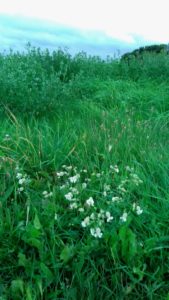
Sea Campion between the A206 and Gascoyne Drive/Perry Street Farm, where it is almost certainly of garden origin or from imported soil.
Common Toadflax (Linaria vulgaris) also grows on the triangle and the farm itself.
The Scotch or Burnet Rose (Rosa spinosissima – syn pimpinellifolia) is a native, but not in Bexley, and has a number of selected horticultural forms. One such, which larger hips, is picture in Stoneham Park by the farm fence.
Fennel (Foeniculum vulgare), a member of the Carrot family, is a thinly scattered plant in the Borough, usually found where the sward is not too thick and there was some bare ground, at least to start with.
Wild Carrot (Daucus carota) itself grows on the northern margin of the farm.
Despite the scientific name, Common Mallow (Malva sylvatica) is way more often seen out of woods than in them. Its leaves can be cooked and eaten.
Soapwort (Saponaria officinalis) is a plant long ago introduced the Britain from continental Europe, and it has been and can be used to make soap. It grows on and at the margin of the farm.
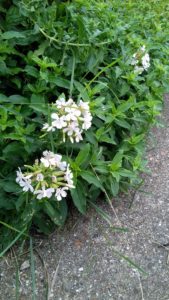
A white-flowered Soapwort by Gascoyne Drive. There are garden forms with other colours, and also double flowers.
Lucerne/Alfalfa (Medicago sativa) shows a considerable range of flower colour in the Borough, mainly from pinkish through shades of violet purple, and sometimes near-black, but also beautiful green/yellow/gold/bronze colours where there is an influence of hybridisation with the closely related, yellow-flowered Sickle Medick.
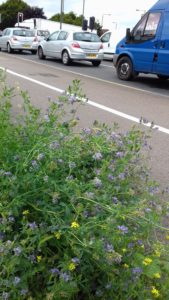
Lucerne (though possibly part of a hybrid swarm), provides nectar and colour by Perry Street roundabout.
Bird’s-foot Trefoil (Lotus corniculatus) is a reasonably frequent member of the Pea family in Bexley, whose attractiveness is best appreciated close up, so is probably overlooked by most people.
The farm was proposed for survey as a potential SINC by Bexley Natural Environment Forum, with London Wildlife Trust agreeing it merited that status in their draft report of December 2013 . Woefully it took Bexley Council’s relevant Cabinet member another 2 years and 10 months after the close of the public consultation in February 2014 to sign off on the draft SINC review, finally doing so in December 2016. Yet more evidence that it sees wildlife as subservient to everything else.
The citation is as follows:
‘A large area of grazed horse paddocks surrounding farm buildings. The ruderal and grassland habitats support a wide variety of typical plants but also includes a small population of the London notable hare’s-foot clover (Trifolium arvense). It is likely to be important for invertebrates and probably also supports reptiles such as the common lizard and slow-worm. The large expanse of undisturbed open grasslands offer important feeding opportunities for starling, house sparrow, kestrel, lapwing, house martins and finches in winter.‘
Text and all photos by Chris Rose.

